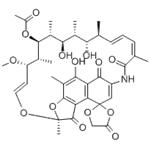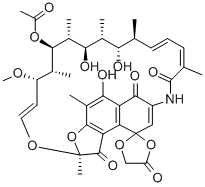Rifamycin O: Efficacy Against M. abscessus and Overcoming Antibiotic Resistance
Rifamycin O is used to treat traveler's diarrhea that is caused by a bacteria called Escherichia coli. Rifamycin is an antibiotic that works by killing the bacteria and preventing its growth. However, this medicine will not work for colds, flu, or other virus infections. Appropriate studies have not been performed on the relationship of age to the effects of Rifamycin O in the pediatric population. Safety and efficacy have not been established.

Rifamycin O, An Alternative Anti-Mycobacterium abscessus Agent
Rifamycin O is an RNA polymerase-targeting antimicrobial agent, and rifampicin is a well-known rifamycin analog. Currently, rifampicin is used to treat tuberculosis and leprosy. Rifampicin binds to the β-subunit (RpoB) of the DNA-dependent RNA polymerase in prokaryotes, and consequently inhibits bacterial transcription. However, rifampicin is not an effective agent against M. abscessus because M. abscessus contains target-modifying enzymes such as intrinsic ADP-ribosyltransferase (MAB_0591 gene product Arr_Mab) that mediate Rifamycin O resistance. Based on the findings reported by Rominski et al., the genetic approach with the Arr_Mab-deletion mutant showed much lower minimum inhibitory concentration (MIC) values than the parental strain, and its compensated strain restored the wild type phenotype against rifamycin. This study aimed to search for alternative compounds for treatment of M. abscessus infections by screening all available compounds deposited in the Korea Chemical Bank (KCB) library. Screening was conducted using a bioluminescent M. abscessus-based assay, and MIC values of the hits were generated by resazurin microtiter assay. The sorted optimal compound was rifamycin O, its activity was subsequently evaluated against different strains and subspecies of M. abscessus either in vitro or in vivo using zebrafish (ZF) as a model of infection.[1]
Utilizing an in vivo ZF-infection model, we injected M. abscessus CIP 104536T R via the caudal vein into early embryos and initiated treatment with rifamycin O and reference compounds to confirm rifamycin O activity against early M. abscessus infection. Microinjection of M. abscessus CIP 104536T R resulted in the death of nearly all infected ZF by 13 dpi, while treatment with it resulted in a significantly enhanced lifespan of up to 13 days (~54% survival rate); this result was similar to the treatment with rifabutin (~50% survival rate). Furthermore, rifamycin O treatment showed excellent bacterial reduction in CFU quantification, and Ziehl–Neelsen staining. Based on these results, we concluded that rifamycin O shows promise as an in vivo anti-M. abscessus compound. However, we have yet to test its activity against infection in a higher animal model. Testing the in vivo efficacy of rifamycin O in immunocompromised mice will be a viable and worthy study to conduct in future.
Redesign of Rifamycin Antibiotics to Overcome ADP‐Ribosylation
Antimicrobial resistance (AMR) is a significant and ever‐increasing burden to public health with roughly 2–5 million annual deaths attributed to AMR worldwide. Among the resistance mechanisms adopted by microorganisms, enzymatic inactivation of antibiotics is among the earliest identified, tracing back to 1940 when the first β‐lactamase was reported to “destroy penicillin”. The natural product‐derived Rifamycin O antibiotics function as inhibitors of bacterial transcription by allosteric binding to bacterial DNA‐dependent RNA polymerases (RNAPs) preventing elongation of the nascent RNA and exhibit exceptional sterilizing activity against Mycobacterium tuberculosis and many other pathogens. With nanomolar antibacterial activity, rifamycins are specifically known for their clinical value in the treatment of persistent bacterial and mycobacterial infections due to their remarkable potency against bacterial persisters, often in biofilms and under dormant states, that are highly tolerant to most antibiotics. However, rifamycin O drugs are clinically ineffective against Mycobacterium abscessus, an emerging nontuberculous mycobacteria that causes an often fatal pulmonary infection with no reliable treatment options since M. abscessus is intrinsically drug resistant to virtually all antibacterial classes.[2]
In conclusion, we have rationally redesigned rifabutin to restore the low nanomolar antimycobacterial activity of Rifamycin O antibiotics and extend their clinical utility against intrinsically multidrug‐resistant M. abscessus by evading a novel rifamycin resistance mechanism. Structure‐based derivatization at the C‐25 position of rifabutin afforded analogs that are more than a hundred‐fold more potent than the widely used rifampicin and are no longer susceptible to the primary Rifamycin O resistance in M. abscessus through ADP‐ribosylation. X‐ray crystallography and molecular docking studies suggest that additional ligand‐target interactions contribute to the favored on‐target activity. The ability to overcome Arr‐mediated resistance was validated using an in vitro biochemical assay to directly detect ADP‐ribosylation, with results congruent with the observed microbiological activity using WT and Δarr M. abscessus strains.
References
[1]Hanh BTB, Park JW, Kim TH, Kim JS, Yang CS, Jang K, Cui J, Oh DC, Jang J. Rifamycin O, An Alternative Anti-Mycobacterium abscessus Agent. Molecules. 2020 Mar 31;25(7):1597. doi: 10.3390/molecules25071597. PMID: 32244387; PMCID: PMC7181020.
[2]Lan T, Ganapathy US, Sharma S, Ahn YM, Zimmerman M, Molodtsov V, Hegde P, Gengenbacher M, Ebright RH, Dartois V, Freundlich JS, Dick T, Aldrich CC. Redesign of Rifamycin Antibiotics to Overcome ADP-Ribosylation-Mediated Resistance. Angew Chem Int Ed Engl. 2022 Nov 7;61(45):e202211498. doi: 10.1002/anie.202211498. Epub 2022 Oct 12. PMID: 36222275; PMCID: PMC9633546.
Lastest Price from Rifamycin O manufacturers

US $1.00-1.00/KG2025-01-03
- CAS:
- 14487-05-9
- Min. Order:
- 1g
- Purity:
- 99%
- Supply Ability:
- 50tons

US $0.00-0.00/kg2023-11-01
- CAS:
- 14487-05-9
- Min. Order:
- 0.1kg
- Purity:
- 99.0%min
- Supply Ability:
- 200kg


